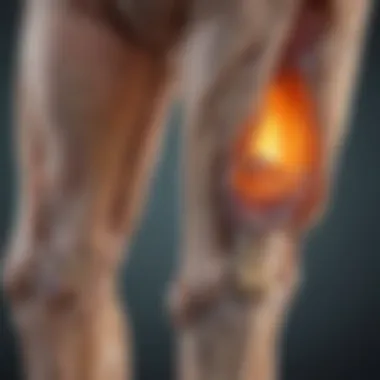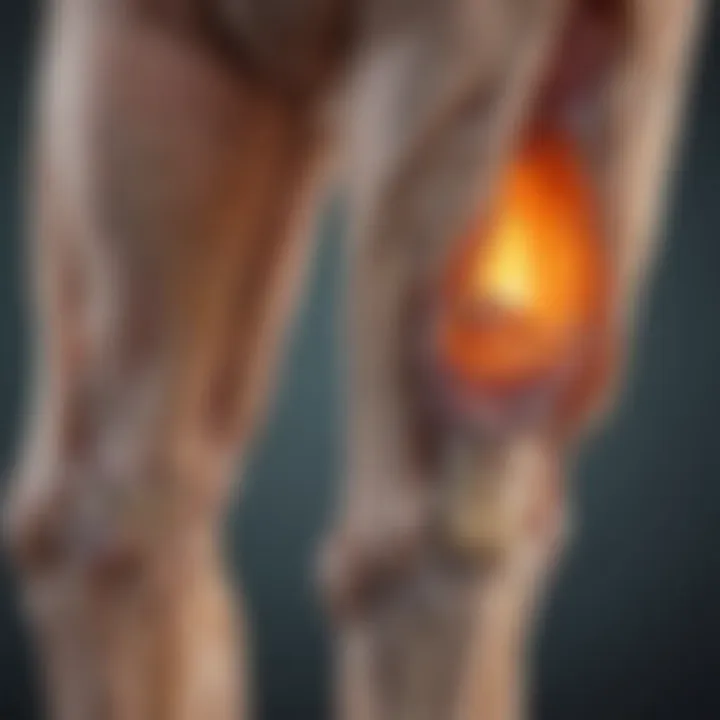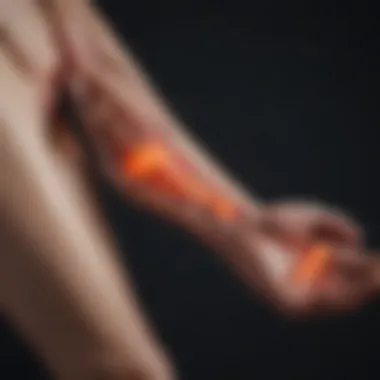Ortho Arthritis: Mechanisms, Impacts & Management


Overview of Research Topic
Brief Background and Context
Ortho arthritis, also known as osteoarthritis, represents a common chronic joint disorder marked by the degeneration of cartilage, leading to pain, stiffness, and eventual loss of joint function. It is often referred to as a "wear and tear" condition, primarily affecting older adults. However, emerging evidence indicates that it can also affect younger individuals, particularly those with risk factors such as obesity, joint injuries, and genetic predisposition. Understanding the mechanisms underlying ortho arthritis can help in developing effective interventions and improving patient outcomes.
Importance in Current Scientific Landscape
In the realm of orthopedic research and clinical practice, ortho arthritis holds significant relevance due to its prevalence and impact on quality of life. With millions of people affected globally, the burden of this degenerative disease emphasizes the need for comprehensive understanding and effective management strategies. Current research efforts are aiming to uncover the complex biological pathways involved in the disease's onset and progression. Such knowledge is crucial for fostering innovations in treatment modalities, including pharmacological and non-pharmacological interventions.
Methodology
Research Design and Approach
The investigation into ortho arthritis employs a multifaceted research design encompassing both quantitative and qualitative approaches. Longitudinal studies often track the progression of the disease, while cross-sectional studies help in assessing the prevalence among different demographics. Clinical trials are critical for evaluating the effectiveness of new therapeutic strategies and medications, facilitating evidence-based practice.
Data Collection Techniques
Data on ortho arthritis are collected through various methods:
- Surveys and Questionnaires: Used to assess pain levels, functional disability, and quality of life among individuals with ortho arthritis.
- Imaging: MRI and X-rays provide insight into the structural changes in joints.
- Biomarkers: Researchers analyze blood and joint fluid for markers that may indicate disease progression.
- Patient Registries: Collecting data over time to observe treatment outcomes and patient experiences.
Current understanding of ortho arthritis suggests that early intervention is crucial to slow disease progression and improve patient quality of life.
These methodologies, among others, facilitate a comprehensive understanding of ortho arthritis, its pathophysiology, risk factors, and treatment approaches.
Prelude to Ortho Arthritis
Understanding ortho arthritis is crucial for several reasons. First, it's a widespread condition that affects millions of individuals globally. Knowledge about ortho arthritis can empower patients and caregivers through better recognition of symptoms and prompt treatment. This section will provide a clear understanding of what ortho arthritis is, its implications, and why it should be studied.
Definition and Overview
Ortho arthritis, often termed osteoarthritis, is primarily known as a degenerative joint disease. It involves the wear and tear of cartilage, the protective tissue at the ends of bones. Over time, this degeneration leads to pain, stiffness, and reduced mobility in the affected joints. Unlike inflammatory forms of arthritis, osteoarthritis is typically non-inflammatory but can have inflammatory components in the later stages.
Understanding this distinction is vital. It shapes expectations for treatment and management strategies. Patients might seek interventions beyond pain relief to maintain or improve joint function.
Prevalence and Epidemiology
The prevalence of ortho arthritis rises sharply with age. Statistics indicate that nearly 27 million adults in the United States suffer from osteoarthritis. This number is expected to rise as the population ages. Additionally, gender plays a role in the disease. Women are more likely to develop osteoarthritis than men, particularly after menopause.
Factors such as obesity, physical inactivity, and joint injuries contribute to the increased prevalence. The cumulative stress on joints from weight and previous injuries can accelerate the onset of the disease. Understanding these trends helps highlight the urgent need for public health initiatives focused on prevention and management.
In summary, the introduction provides an essential framework to delve into ortho arthritis. The following sections will explore its mechanisms, impacts, and management strategies in greater detail.
Pathophysiology of Ortho Arthritis
Understanding the pathophysiology of ortho arthritis is crucial as it underpins the mechanisms that lead to joint degeneration, influencing both clinical presentation and treatment strategies. This section examines key aspects of how the disease develops and progresses, helping readers appreciate the complexity of ortho arthritis.
Joint Anatomy and Function
The human joint consists of several components, including cartilage, bones, ligaments, and synovial fluid. Cartilage serves as a cushion, providing support while allowing for smooth movement between bones. This cartilage is avascular, meaning it lacks blood vessels, which complicates its repair when damaged.
With age or due to injury, cartilage may degrade. As the cartilage deteriorates, it loses its ability to absorb shocks. This results in increased friction during joint movement, causing pain and stiffness. The joint's function is compromised, leading to difficulty in performing daily activities. Understanding the anatomy and function of joints is essential as it lays the foundation for recognizing signs of ortho arthritis.
Alterations in Cartilage
Cartilage changes are fundamental in the progression of ortho arthritis. Unlike healthy cartilage, osteoarthritic cartilage undergoes biochemical alterations. These changes involve a loss of proteoglycans, essential for cartilage hydration and elasticity.
When proteoglycan content decreases, cartilage becomes brittle and more susceptible to wear. Micro-tears and cracks develop, allowing bone-to-bone contact. This can lead to osteophyte formation, or bone spurs, which exacerbate pain and further limit mobility. These alterations are critical for understanding the pathophysiological processes that contribute to joint dysfunction in patients with ortho arthritis.
Synovial Fluid Changes
Synovial fluid, a viscous substance that lubricates joints, undergoes significant changes in ortho arthritis. Healthy synovial fluid contains hyaluronic acid, which provides viscosity. In contrast, osteoarthritis leads to reduced viscosity and altered composition of this fluid.
As arthritis progresses, synovial fluid may become less effective in reducing friction between joint surfaces. Inflammatory cytokines can also be present in higher concentrations. This change stirs inflammation in the joint capsule, contributing to the classic symptoms of ortho arthritis, particularly swelling and pain. The alteration in synovial fluid underscores the interplay between mechanical stress and inflammatory responses, shedding light on the complex nature of this joint disease.
Understanding these mechanisms is pivotal for developing effective therapeutic strategies. A comprehensive grasp of the pathophysiology allows for targeted approaches in treating ortho arthritis.
The interplay between joint anatomy, cartilage health, and synovial fluid composition is essential to understanding ortho arthritis. Each component plays a specific role in how the disease manifests and evolves, ultimately affecting the patient's quality of life.


Risk Factors Associated with Ortho Arthritis
Understanding the risk factors related to ortho arthritis is vital. These factors can indicate who is more likely to develop the disease and can guide preventive efforts. By identifying at-risk populations, targeted interventions can be implemented to reduce incidence and severity. This section outlines various risk factors that contribute to the development of ortho arthritis, including genetic, age-related, lifestyle, and injury history.
Genetic Predispositions
Genetics plays a significant role in the likelihood of developing ortho arthritis. Certain genes can influence cartilage integrity and joint health. Studies indicate that a family history of osteoarthritis often correlates with increased risk. Specific genetic markers, such as those affecting collagen production, have been linked to the disease. Understanding these genetic predispositions can help in early detection and personalized management plans. Genetic testing may be considered for individuals with a strong family history, allowing for proactive strategies to be put in place.
Age and Gender Considerations
Age is a primary risk factor for ortho arthritis. With advancing age, the likelihood of joint degeneration increases. The condition is more prevalent in individuals over 50 years old, emphasizing the need for regular joint assessments in older adults. Gender also plays a role. Research shows that women are more likely to develop osteoarthritis, particularly after menopause. Hormonal changes may contribute to cartilage changes, warranting this gender-specific consideration. Awareness of these factors can lead to more effective screening and necessary lifestyle adjustments for at-risk groups.
Obesity and Joint Stress
Obesity significantly impacts joint health. Excess body weight adds stress to weight-bearing joints, particularly the knees and hips. This increased load can accelerate cartilage breakdown. Studies indicate that losing just 5-10% of body weight can reduce the risk of developing ortho arthritis by up to 50%. Weight management programs, therefore, are critical in preventing and managing the condition. Incorporating dietary changes and regular physical activity can help mitigate this risk.
Previous Joint Injuries
History of joint injuries is another notable risk factor. Injuries such as fractures or ligament tears can lead to altered joint function and increased wear and tear over time. These past traumas can predispose individuals to develop ortho arthritis later in life. Immediate rehabilitation and careful monitoring of injured joints are essential to minimize long-term consequences. Awareness of this risk emphasizes the importance of seeking appropriate treatment for joint injuries to preserve joint health.
"Understanding risk factors enables better prevention and management strategies, ultimately improving outcomes for those with orth oarthritis."
In summary, multiple factors contribute to the probability of developing ortho arthritis. Genetic predispositions, aging, obesity, and previous injuries all shape the risk landscape. Identifying and understanding these elements is imperative for effective prevention and a watershed for improving quality of life in those affected.
Clinical Manifestations of Ortho Arthritis
Understanding the clinical manifestations of ortho arthritis is a cornerstone of effective diagnosis and management. The symptoms indicative of this condition not only impact the patient's quality of life but also serve as important signaling mechanisms for healthcare providers. An acute awareness of these manifestations can lead to timely interventions, ultimately minimizing long-term disablement.
Joint Pain and Stiffness
Joint pain and stiffness are hallmark symptoms of ortho arthritis. The discomfort typically worsens with activity and improves with rest. Patients often describe a deep, aching pain that limits their ability to engage in daily tasks. The stiffness tends to be particularly pronounced after periods of inactivity, such as upon waking or after sitting for long durations. This can lead to a cycle where pain prompts decreased physical activity, further exacerbating stiffness and weakening the muscles surrounding the joint.
Management strategies often include a combination of pharmacological interventions, such as NSAIDs, and adaptive physical therapies. Understanding the severity and frequency of pain is crucial for health professionals when crafting personalized treatment plans.
Swelling and Inflammation
Swelling and inflammation in the joints are direct consequences of the underlying pathological processes in ortho arthritis. When tissue in the joint becomes inflamed, it can result in visible swelling that can alter the shape of the joint. This inflammation can also lead to an increased temperature around the joint area, adding to patient discomfort. Persistent swelling may indicate active inflammation, which requires careful assessment and may necessitate adjustments in therapeutic interventions.
Monitoring the degree of swelling can guide clinicians in managing both acute flare-ups and chronic symptoms. Effective strategies may involve corticosteroids or other anti-inflammatory medications.
Range of Motion Limitations
Limitations in the range of motion are another critical manifestation of ortho arthritis. As cartilage degenerates and joint structures become compromised, the ability to move the affected joint freely can be significantly reduced. Patients often report difficulty performing essential movements, whether it be bending their knees or reaching their arms overhead.
This restriction not only hinders physical function but also influences mental well-being, as individuals may feel increasingly dependent on others for assistance. Therefore, rehabilitation strategies that emphasize gentle, guided exercises can be beneficial. The goal is to maintain or improve the joint's functionality while minimizing discomfort.
"Awareness and understanding of joint pain, swelling, and motion limitations can lead to effective management and improved quality of life for those living with ortho arthritis."
In summary, recognizing these clinical manifestations lays the groundwork not only for diagnosis but also for a holistic management approach. Health professionals must remain vigilant regarding these symptoms as they play an essential role in tailoring effective treatment plans to optimize patient outcomes.
Diagnostic Approaches to Ortho Arthritis
Understanding the diagnostic approaches to ortho arthritis is essential for identifying the condition early and tailoring management strategies. Accurate diagnosis can lead to effective treatments, which can significantly affect the quality of life for patients. The approaches typically combined include clinical evaluation, imaging studies, and laboratory tests. Each element provides unique insights, allowing healthcare professionals to create a comprehensive understanding of the patient's condition.
Clinical Evaluation
The clinical evaluation serves as the foundation for diagnosing ortho arthritis. It involves a thorough assessment of the patient's medical history and a detailed physical examination. During this process, the clinician looks for characteristic symptoms such as joint pain, stiffness, and mobility limitations. This evaluation helps in distinguishing ortho arthritis from other types of arthritis, such as rheumatoid arthritis.
Another important aspect here is that patient-reported symptoms are taken into account. This includes information about the duration and intensity of symptoms, any history of joint injuries, and familial patterns of joint issues. The clinical evaluation is crucial because it sets the stage for subsequent diagnostic steps, ensuring that no potential red flags are overlooked.
Imaging Studies
Imaging studies play a critical role in the diagnosis of ortho arthritis. They provide valuable visual information about the joints and surrounding structures that can clarify the extent of degeneration.
X-rays
X-rays are often the first imaging technique used when diagnosing ortho arthritis. They help in identifying joint space narrowing, bone spurs, and other changes that indicate the disease’s progression. The key characteristic of X-rays is their ability to offer a quick and non-invasive view of the bones and joints. This makes them a beneficial choice for initial assessments.
One unique feature of X-rays is their capacity to reveal chronic changes that may not always correlate with the severity of symptoms. Patients may experience significant discomfort while X-ray findings appear minimal. However, the advantage of X-rays lies in their availability and speed. The disadvantage is that they do not highlight soft tissue problems, which might also play a role in the patient’s symptoms.


Magnetic Resonance Imaging
Magnetic Resonance Imaging (MRI) provides a more detailed view of joint structures, including cartilage, ligaments, and synovial tissues. This imaging method allows for the visualization of soft tissues that X-rays cannot capture. A key characteristic is its ability to detect early changes in cartilage, which can be critical for timely intervention.
The unique feature of MRI is its detailed imaging capability. It can reveal inflammation and other conditions not detectable by X-rays. While MRI is highly beneficial, its limitations include longer scan times and higher costs, which may not be accessible in all medical settings. Importantly, MRI can offer insights that critically inform management strategies for ortho arthritis.
Laboratory Tests
Laboratory tests are another component that contributes to the overall diagnostic picture. These tests can help rule out other conditions through blood analysis that checks for markers of inflammation, such as C-reactive protein and erythrocyte sedimentation rate. Additionally, tests for rheumatoid factor can be valuable if the arthritis type is in question.
Treatment Strategies for Ortho Arthritis
Understanding the treatment strategies for ortho arthritis is crucial for those impacted by the disease. These strategies are designed to alleviate pain, improve joint function, and enhance overall quality of life. The chosen approach can vary based on the severity of symptoms, the specific needs of the patient, and various individual factors. The integration of pharmacological and non-pharmacological strategies, along with potential surgical options, forms a comprehensive treatment plan that aims for effective management of this degenerative joint disease.
Pharmacological Options
Pharmacological treatment of ortho arthritis plays a pivotal role in managing symptoms and improving functionality. Here, we focus on three main classes of drugs: nonsteroidal anti-inflammatory drugs (NSAIDs), corticosteroids, and disease-modifying antirheumatic drugs (DMARDs).
NSAIDs
NSAIDs are commonly used to reduce pain and inflammation in patients with ortho arthritis. They work by inhibiting enzymes responsible for causing pain and inflammation, thus providing relief.
A key characteristic of NSAIDs is their availability in both prescription and over-the-counter forms. This accessibility makes them a popular choice among patients seeking immediate relief from discomfort. Moreover, NSAIDs can be effective for long-term use, allowing for ongoing management of arthritis symptoms.
However, one significant drawback is the potential for gastrointestinal complications such as ulcers or bleeding. This risk necessitates careful consideration of dosage and duration of use.
Corticosteroids
Corticosteroids serve as a powerful anti-inflammatory treatment. They are prescribed to manage acute flare-ups of ortho arthritis. Their benefit lies in their rapid action, which can provide significant relief from severe inflammation.
The unique feature of corticosteroids is their ability to restore function quickly. This can be particularly advantageous in acute settings. However, risks such as weight gain, increased blood sugar levels, and potential skin changes can occur with prolonged use. As a result, they are often used cautiously and for short durations when necessary.
DMARDs
Disease-modifying antirheumatic drugs (DMARDs) primarily focus on slowing the disease progression itself, rather than just alleviating symptoms. This aspect makes them an essential component of arthritis management in patients with more severe cases.
DMARDs can alter the disease's course, potentially leading to long-term benefits for joint health. Their distinguishing quality is the ability to provide long-lasting effects, potentially decreasing the need for other medications over time. However, patients must be monitored closely for side effects, as DMARDs can impact immune function and may lead to other health issues.
Non-Pharmacological Approaches
Non-pharmacological strategies are vital aspects of a well-rounded approach to ortho arthritis management. These methods often work in concert with medications to optimize patient outcomes.
Physical Therapy
Physical therapy targets muscle strength and joint function. It involves exercises that improve flexibility, strength, and endurance in the affected joints. This method aims to enhance a patient's overall mobility and reduce pain. The key characteristic of physical therapy is its tailored approach, as each session can be customized based on individual needs.
A unique feature of physical therapy is its focus on non-invasive strategies to achieve functional improvements. Furthermore, this approach may help reduce dependence on medications, thereby minimizing potential side effects associated with long-term drug use. However, commitment to regular sessions and exercises is crucial for success.
Occupational Therapy
Occupational therapy assists individuals in adapting their daily activities to manage pain and improve function. It helps patients learn techniques to perform tasks efficiently while minimizing stress on their joints.
The essential benefit of occupational therapy lies in its focus on enhancing quality of life. By incorporating adaptive strategies in daily routines, patients can maintain independence in their daily activities. Nonetheless, the effectiveness of this therapy requires active participation from the patient to make necessary adjustments.
Weight Management
Weight management is closely related to joint health, especially in cases of obesity. Reducing excess weight can significantly lessen the stress on weight-bearing joints, thereby alleviating pain and improving function.
The key feature of weight management programs is their holistic nature. These typically include dietary changes combined with physical activity, targeting overall health improvement. While weight loss can substantially enhance joint function, maintaining motivation and adhering to lifestyle changes can prove challenging for many patients.
Surgical Interventions
In severe cases of ortho arthritis where other treatments fail to provide relief, surgical intervention may become necessary. Surgical options can offer definitive solutions for restoring joint function.
Arthroscopy
Arthroscopy is a minimally invasive procedure used to diagnose and treat joint issues. Surgeons can visualize the inside of a joint and address problems like loose cartilage or debris, thus alleviating discomfort.
The primary advantage of arthroscopy is its reduced recovery time compared to traditional surgeries. Patients often experience less postoperative pain and a quicker return to daily activities. However, it may not be suitable for all situations, particularly if there is significant joint damage.


Joint Replacement
Joint replacement surgery is another option for patients with advanced ortho arthritis, particularly in hips and knees. This procedure involves removing damaged joint surfaces and replacing them with artificial components, significantly improving quality of life.
The hallmark of joint replacement is its potential to restore function and alleviate pain effectively. Many patients report substantial improvements in mobility and a decrease in discomfort. Nevertheless, surgical risks, including infections and the need for rehabilitation, must be carefully considered before opting for this intervention.
Recent Advances in Ortho Arthritis Research
Research in ortho arthritis has gained momentum in recent years. Understanding the complexities surrounding this degenerative joint disease is critical. Advances play a vital role in shaping effective intervention strategies and improving patient outcomes. Emerging therapies and treatment modalities can transform the landscape, offering new hope to those affected by this condition.
Biologics and Their Role
Biologics are a category of medicines derived from living organisms. They have shown potential in modulating the immune response in ortho arthritis. The use of biologics targets specific pathways involved in inflammation and cartilage degradation. Consequently, these treatments may lead to significant improvements in pain management and joint function for patients.
Research is focused on particular biologic drugs such as tocilizumab, which has demonstrated effectiveness in clinical trials. Moreover, these agents come with the advantage of fewer side effects compared to traditional medications. Their targeted approach allows for more tailored therapies, enhancing the overall patient experience.
Regenerative Medicine Approaches
Regenerative medicine represents another frontier in ortho arthritis research. This approach aims to restore the function of damaged tissues or organs. In the case of ortho arthritis, several techniques are being explored. These include stem cell therapy and platelet-rich plasma (PRP) treatments.
The potential benefits of these therapies lie in their ability to promote healing and repair joint structures. Early studies suggest that stem cells can differentiate into cartilage cells, potentially slowing disease progression. PRP contains growth factors that can stimulate tissue repair, offering an innovative approach to joint preservation.
Future Directions in Research
Looking ahead, the future of ortho arthritis research is promising. Several key areas are being investigated. Genetic studies may uncover the hereditary factors contributing to disease development, leading to more personalized treatments. Additionally, ongoing research into the microbiome’s role could also yield new insights.
Clinical trials are crucial for validating emerging therapies. As more evidence accumulates, practitioners can make informed decisions related to patient care. Ultimately, fostering collaboration between researchers, clinicians, and patients will enhance the potential for breakthroughs in ortho arthritis management.
"Innovations in ortho arthritis research can pave the way for better treatment outcomes and improved quality of life for patients."
Overall, keeping abreast of these advances is essential for healthcare professionals and patients alike. Awareness of new treatment modalities can empower individuals and encourage proactive management of the condition.
Patient Perspectives and Quality of Life
Understanding patient perspectives in ortho arthritis is crucial as it sheds light on how this condition affects individuals beyond clinical symptoms. The subjective experience of pain, mobility limitations, and overall quality of life are vital components that healthcare professionals must consider. Engaging with patients allows for tailored treatments that align better with their daily experiences and expectations. Effective management of ortho arthritis takes into account not just the disease itself but how it intertwines with patients' lives.
Impact on Daily Living
Ortho arthritis profoundly affects daily living. Many patients report difficulties in performing routine activities such as walking, climbing stairs, or even sitting for extended periods. This impact extends into various aspects of life:
- Physical Limitations: Patients often find it challenging to engage in their favorite hobbies or work due to joint pain and stiffness.
- Employment Challenges: Job performance may decline because of fatigue or reduced mobility, leading to job loss or job changes.
- Social Isolation: The fear of pain can lead individuals to withdraw from social events, creating feelings of loneliness.
Addressing these daily challenges through supportive interventions is crucial. This could involve physical therapy, occupational therapy, or community support groups. Understanding these aspects helps in developing programs to enhance patients' lives and reduce feelings of helplessness.
Psychosocial Factors
The psychosocial factors related to ortho arthritis are significant yet often overlooked. The interplay between mental health and chronic pain can create a cycle that worsens the overall condition. Here are some key elements to consider:
- Anxiety and Depression: Chronic pain can lead to increased rates of anxiety and depression, affecting how individuals cope with their diagnosis.
- Coping Mechanisms: Those who find effective coping strategies tend to experience better outcomes. Support systems, such as family, friends, and counseling, are invaluable.
- Education and Awareness: Enhancing patient knowledge about ortho arthritis can also positively influence psychological well-being, empowering patients to take control of their situation.
A well-rounded approach that respects patient perspectives may prevent complications and improve general health.
Incorporating these psychosocial considerations into management strategies is vital. This can lead to a more holistic understanding of ortho arthritis and its effects on life quality, ultimately aiding healthcare providers in offering more personalized care.
Culmination
The conclusion serves as a critical section of this article, emphasizing the core ideas that have been explored. It connects the various threads of ortho arthritis, demonstrating the complex nature of this degenerative joint disease. The conclusion reiterates the significance of understanding both the biological mechanisms and real-world impacts of ortho arthritis on individuals’ lives.
In this article, the journey through the pathophysiology, risk factors, symptoms, diagnostics, and treatment options has highlighted the necessity for early identification and comprehensive management. Recognizing the impact of ortho arthritis on daily activities and mental well-being is vital for both patients and healthcare professionals. By doing so, we can improve the overall quality of care. In essence, the conclusion underscores three important elements:
- Empowerment through Knowledge: Understanding the subtleties of ortho arthritis allows patients and practitioners to make informed choices regarding effective management.
- Focus on Holistic Care: Acknowledging psychosocial factors and lifestyle adjustments is crucial for patient's emotional and physical well-being.
- Continuous Research and Adaptation: Advancements in research foster new treatments and strategies that can elevate the standard of care.
"Effective management of ortho arthritis requires a multidisciplinary approach that prioritizes patient education alongside advanced treatment methods."
Overall, a comprehensive understanding of ortho arthritis can significantly improve outcomes for those affected and foster better communication between patients and healthcare providers.
Summary of Key Insights
Throughout this article, several key insights have emerged about ortho arthritis, which is primarily characterized by the degeneration of joint cartilage and underlying bone.
- Pathophysiology: The relationship between joint structure and function is essential in understanding ortho arthritis. Changes such as cartilage degeneration and alterations in synovial fluid can greatly impact mobility.
- Risk Factors: Various factors, including age, genetics, and obesity, contribute to the likelihood of developing ortho arthritis. Identifying these factors is crucial for preventive measures.
- Clinical Manifestations: Patients report symptoms like pain, stiffness, and reduced range of motion, which significantly affect their quality of life.
- Assessment and Treatment: Timely diagnosis using imaging techniques and laboratory tests is pivotal. Treatment strategies vary from pharmacological to non-pharmacological options, aiming to reduce pain and improve function.
Future Outlook for Ortho Arthritis Management
The future of ortho arthritis management looks promising with ongoing advancements in research and treatment options.
- Innovative Therapies: Biologics and regenerative medicine, such as stem cell therapy, offer new pathways for treating joint degeneration. These approaches target the underlying causes instead of merely alleviating symptoms.
- Personalized Medicine: The shift toward personalized treatment plans allows healthcare providers to tailor interventions based on individual patient profiles, improving outcomes.
- Public Awareness: Increased education about ortho arthritis can empower patients to seek help earlier, leading to better management and quality of life.



